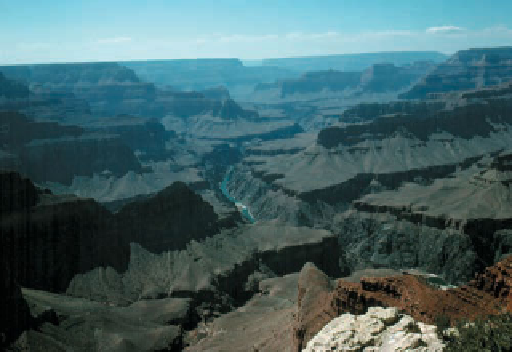Geology Reference
In-Depth Information
2. The Grand Canyon
is world famous for its
grandeur and beauty, and
attracts approximately fi ve
million visitors a year. Mo-
have Point, on West Rim
Drive, is a popular spot to
view the South Rim of the
Grand Canyon and the sur-
rounding plateau area.
3. Major John Wesley
Powell, a Civil War vet-
eran, led the fi rst geo-
logic expedition down the
Colorado River through
the Grand Canyon in
1869. Following this
fi rst exploration, he led
a second expedition in
1871, in which detailed
topographic and geologic
maps of the area were
made.
6. The South Rim of the Grand Canyon as viewed from Mohave
Point. The Colorado River, which can be seen in the center of
this view, is responsible for carving the Grand Canyon and other
canyons during the past 30 million years or so in response to the
general uplift of the Colorado Plateau.
4. The rocks of the Grand
Canyon record more
than one billion years of
Earth history. The Vishnu
Schist represents a ma-
jor mountain-building epi-
sode that occurred during
the Precambrian. Follow-
ing erosion of this moun-
tain range, sediments
were deposited in a va-
riety of marine, coastal,
and terrestrial settings
during the Paleozoic Era,
and were lithifi ed into the
rock formations that are
now exposed in the can-
yon walls.
Kaibab Ls
Toroweap Fm
Permian Period
Coconino Ss
Hermit Shale
Pennsylvanian Period
Supai Fm
7. White aspen and
pinyon pine are
typical of the trees
found in the Grand
Canyon. Ponderosa
pine is the dominant
tree above elevations
of 2134 m, whereas
pinyon pine and
Utah juniper are the
dominant trees be-
low 2134 m. Shown
here are white aspen
and pinyon pines in
the DeMotte camp-
ground, 28 km north
of the North Rim.
Mississippian Period
Redwall Ls
Mauv Ls
Bright Angel Shale
Cambrian Period
Colorado
River
Tapeats Ss
Vishnu Schist
Precambrian
Fm = Formation
Ss = Sandstone
Ls = Limestone
5. The red-colored Hermit Shale and the overlying cross-bedded
Coconino Sandstone are exposed along the North Kaibab Trail
in the North Rim of the Grand Canyon and are both of Permian
age. The Hermit Shale contains many plant fossils, indicating
that it was deposited in a terrestrial environment. Large-scale
cross-beds, such as these seen in the Coconino Sandstone, are
evidence of sand dunes and blowing winds.
535




































































































































Search WWH ::

Custom Search